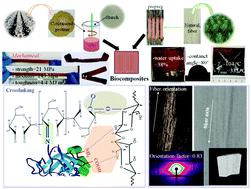当前位置:
X-MOL 学术
›
Green Chem.
›
论文详情
Our official English website, www.x-mol.net, welcomes your
feedback! (Note: you will need to create a separate account there.)
On the improvement of properties of bioplastic composites derived from wasted cottonseed protein by rational cross-linking and natural fiber reinforcement
Green Chemistry ( IF 9.3 ) Pub Date : 2020-11-18 , DOI: 10.1039/d0gc03245j Hangbo Yue 1, 2, 3, 4 , Yuru Zheng 1, 2, 3, 4 , Pingxuan Zheng 1, 2, 3, 4 , Jianwei Guo 1, 2, 3, 4 , Juan P. Fernández-Blázquez 5, 6, 7 , James H. Clark 8, 9, 10, 11 , Yingde Cui 4, 12, 13
Green Chemistry ( IF 9.3 ) Pub Date : 2020-11-18 , DOI: 10.1039/d0gc03245j Hangbo Yue 1, 2, 3, 4 , Yuru Zheng 1, 2, 3, 4 , Pingxuan Zheng 1, 2, 3, 4 , Jianwei Guo 1, 2, 3, 4 , Juan P. Fernández-Blázquez 5, 6, 7 , James H. Clark 8, 9, 10, 11 , Yingde Cui 4, 12, 13
Affiliation

|
An approach of largely improving the properties of protein-based biopolymers is reported. Cottonseed protein concentrate (CPC) purified from cottonseed protein powder waste, with a protein content of >70% and a plasticizing efficiency of 4.2, was used to produce bioplastic polymer. A prepreg consisting of relatively oriented sisal fiber (SF) was transferred into CPC matrix as reinforcement, giving rise to improved mechanical properties of CPC/SF composites. To enhance interfacial bonding forces between the fiber and polymer, dialdehyde starch, DAS, with varied content (5–30 wt%) was introduced, and the FTIR and NMR results showed that DAS can effectively bridge biomacromolecular chains and form strong chemical bonds within the crosslinked structure. This cross-linking treatment leads to the formation of tight CPC/SF interfaces with strong adhesion, as shown by microscopic images, translating into excellent mechanical performance (e.g. tensile strength 21 MPa), water resistance (e.g. water contact angle 80°) and thermal stability (e.g. glass transition temperature 104 °C) of the composites. The all green composites derived from natural resources with comparable or even superior properties to state-of-the-art biomass-based composites hold great potential for being utilized in larger industries.
中文翻译:

合理交联和天然纤维增强对废棉籽蛋白生物塑料复合材料性能的改善
报道了一种大大改善基于蛋白质的生物聚合物的性质的方法。从棉籽蛋白粉废料中纯化出的棉籽蛋白浓缩物(CPC)的蛋白质含量> 70%,增塑效率为4.2,用于生产生物塑料。由相对取向的剑麻纤维(SF)组成的预浸料被转移到CPC基质中作为增强材料,从而改善了CPC / SF复合材料的机械性能。为了增强纤维与聚合物之间的界面键合力,引入了二醛淀粉DAS(含量为5-30 wt%),并且FTIR和NMR结果表明DAS可以有效桥接生物大分子链并在聚合物内形成牢固的化学键。交联结构。复合材料的抗水性能(例如抗张强度21 MPa),耐水性(例如水接触角80°)和热稳定性(例如玻璃化转变温度104°C)。来自自然资源的所有绿色复合材料具有与最新的基于生物质的复合材料相当甚至更好的性能,在大型工业中具有巨大的潜力。
更新日期:2020-11-23
中文翻译:

合理交联和天然纤维增强对废棉籽蛋白生物塑料复合材料性能的改善
报道了一种大大改善基于蛋白质的生物聚合物的性质的方法。从棉籽蛋白粉废料中纯化出的棉籽蛋白浓缩物(CPC)的蛋白质含量> 70%,增塑效率为4.2,用于生产生物塑料。由相对取向的剑麻纤维(SF)组成的预浸料被转移到CPC基质中作为增强材料,从而改善了CPC / SF复合材料的机械性能。为了增强纤维与聚合物之间的界面键合力,引入了二醛淀粉DAS(含量为5-30 wt%),并且FTIR和NMR结果表明DAS可以有效桥接生物大分子链并在聚合物内形成牢固的化学键。交联结构。复合材料的抗水性能(例如抗张强度21 MPa),耐水性(例如水接触角80°)和热稳定性(例如玻璃化转变温度104°C)。来自自然资源的所有绿色复合材料具有与最新的基于生物质的复合材料相当甚至更好的性能,在大型工业中具有巨大的潜力。











































 京公网安备 11010802027423号
京公网安备 11010802027423号